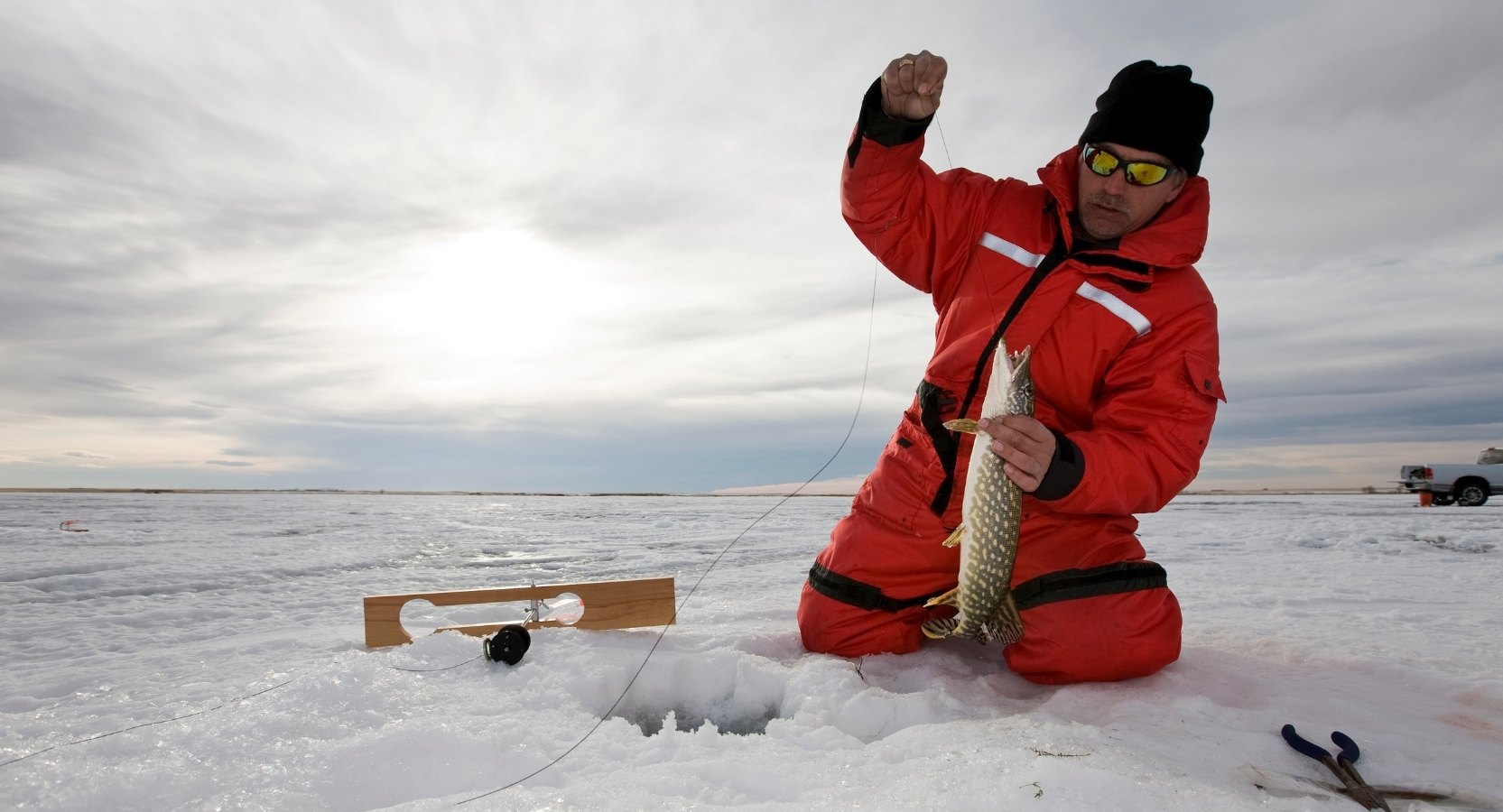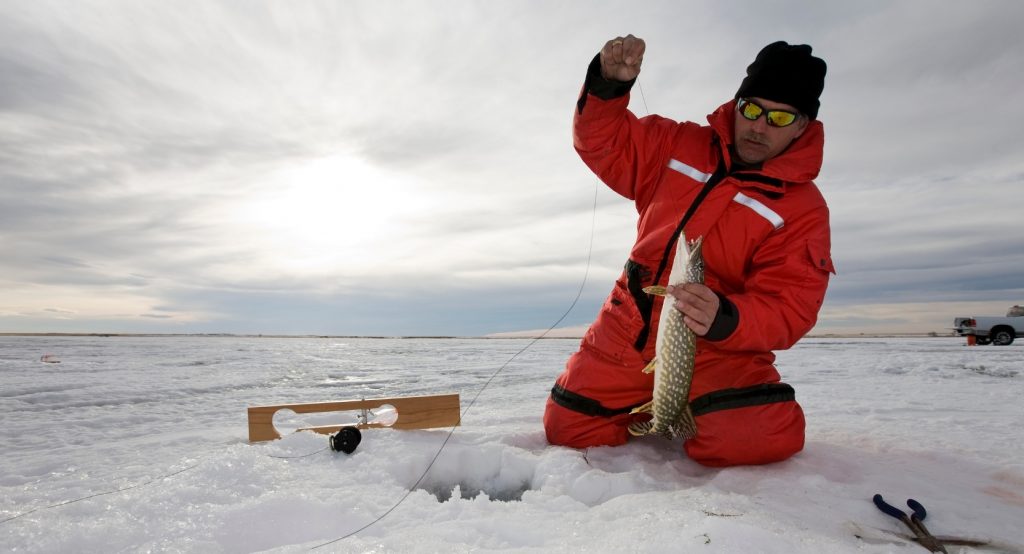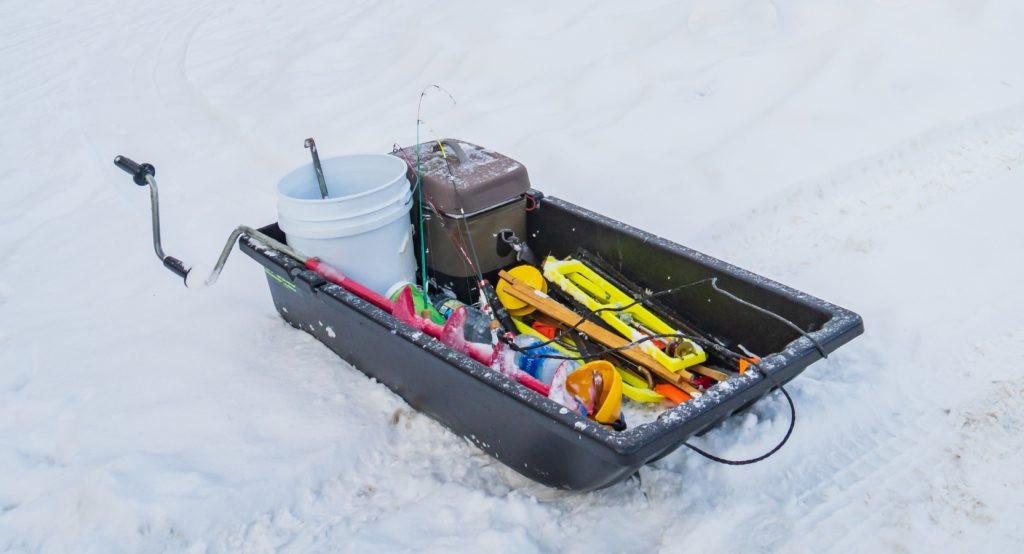Who wants to sit out in the cold and fish in a hole? That was my attitude many years ago, each winter as I was storing my gear away for the season. I had friends who ice fished and always raved about it, but I just couldn’t understand it. Maybe I just didn’t have the right ice fishing setup?
That’s the problem most anglers face. They’re not doing ice fishing right so they’re uncomfortable and unsuccessful. This guide aims to help you break through that glass ceiling that is holding you back. You don’t need to hang up your gear this season, there’s months of fishing ahead!
Compiling the Ultimate Ice Fishing Setup
One of the most exciting things about ice fishing is watching your stockpile of gear, lures, rods, and reels get bigger and bigger each season. I don’t know about you but where I live, ice fishing season seems shorter than ever so compiling everything and having it ready when the ice gets thick enough is crucial.
Let’s take a look at some of the important steps all ice anglers should take with their ice fishing setups.
Ice Fishing Gear List
It all starts with the gear and many of you will know what these are so here’s a quick list to get you rolling: (if you don’t know what some of these things are, don’t worry because I’ll elaborate below)
- Ice fishing rod and reel combo (generally two or three feet in length)
- Ice auger (variety of choices we’ll touch on)
- Ice scoop
- Gaff hook/Picker
- Tip-up (optional)
- Sled (for easy transportation to and from the vehicle)
- Bucket (multi-purpose)
- Fold-up chair
- Plenty of layers
- Waterproof gloves and jacket
- Extra socks
- Rubber boots
- Ice cleats (optional)
- Goggles or large sunglasses
- Facemask
- GPS or GPS fish finder (optional)
- Jigs
That’s a pretty big list so as promised, I’m going to break down some of these to help ensure you have all the necessary ice fishing gear.
Ice Fishing Rod and Reel
When it comes to ice fishing, you don’t have a lot of options. Many people use tip-ups and many people use a basic jigging rod and that’s about all you can do. You can’t cast like traditional fishing so you’re limited to working the bait vertically in the hole.
Due to limited space inside ice fishing cabins and shelters, ice fishing rods are short. Most are about 30-36 inches and you don’t really need anything longer than that.
As for the reels, you can choose whatever you like. There are specific ice fishing reels; these are called “inline reels.” The goal is to help the line flow really smooth off the reel since you can’t build up momentum during the cast. There’s no bail on these so it helps the line lay smooth on the spool as well when you retrieve your bait. Inline reels are designed specifically for vertical fishing so there are some pros to getting one. Do you need it to ice fish? No. Does it help? Yes. If you’re just dabbling in ice fishing, don’t worry too much about this. You can use a spinning reel too.
Ice Auger
You need to drill a hole in the ice if you intend on getting your bait into the water. People do this with something called an ice auger and there are a variety of tools you can choose based on how involved you are in the sport. They have gas-powered augers that create a ton of vibration, make a lot of noise, but they get you through the ice in a few seconds with little effort. They’re also expensive.
On the other side, you can get a manual auger that requires you to crank it yourself. It causes a minimal disturbance, it’s cheap, but it requires a lot of effort on your part. I recommend getting a hand auger if you’re dabbling because it’s not as hard as you think to get through the ice and a power auger is also a pain to lug out.
Gaff Hook/Gripper
While I generally don’t use a gaff because you’re almost guaranteeing that you’ll kill the fish this way, they’re more popular in ice fishing because of how difficult it can be to get the ice out of the hole. Very few people ice fish for sport and most do it with the intention of keeping every legal fish they catch. Still, I recommend using a fish gripper if you can. Many of them come with a scale too so you can immediately tell if the fish is a legal catch or not and release it right away if needed.
Tip-Up
Tip-ups are used in ice fishing to help identify ideal fishing locations. A strategy that a lot of people use is they’ll drill a few holes, insert some tip-ups, and let them work while they warm up for a while. After about 30 minutes, go check the tip-ups and see if any of the bait was taken. If it was, you fish those holes and forget the other ones for now.
A tip-up is a platform with a line, hook, and bait hanging down into the water. You set up the platform on top of the hole and when a fish bites the hook enough, it will trigger the flag and you’ll know to check that tip-up. Even if you don’t catch anything with the tip-up, you’re still identifying ideal fishing locations. You don’t need to use this method but it’s a nice passive way to catch fish while staying warm inside a shelter.
Sled
The first time someone taught me to bring a sled on the ice I felt like such an idiot for manually carrying everything for so long. A sled will save you so much time and it’ll make everything so much easier. Take the sled out and put it on the ground. Load all your gear into the sled and now you can slide it out onto the ice without having to make a ton of trips.
GPS or GPS Fish Finder
Keeping yourself safe when ice fishing should always be a priority and it’s easy to get disoriented when you’re on the ice. A quick snow squall can come by and you’ll have no idea where the shore is so having some form of geographical monitoring is important. Having a GPS fish finder isn’t entirely necessary but let me tell you, it’ll help a lot.
These fish finders work by either sensing fish through the ice or requiring you to throw sensors down into the water. The high-quality ones don’t even require you to drill a hole so it can help you identify good fishing locations without requiring a tip-up.
If you’re not interested in buying a fish finder, having a basic GPS on your phone or a separate unit will help you stay safe and not get lost.
Ice Fishing Rigging
I talked a little about ice fishing rigging when talking about the reels but it’s super simple. When you’re putting together your ice fishing setup, you want to pay attention to the following:
- Can it hold up in the cold?
- Does it work for vertical jigging?
- Can it handle the abrasion of the ice?
- Is it going to work for the current conditions?
These four factors will ultimately make up your success on the water. For me to sit here and give you an exact rig, it’s not possible. Jigging is the most popular method for ice fishing hands down because it works best with a vertical presentation.
If you’d rather use live bait, shiners work nicely for panfish like crappie and bluegill. Most minnows also work for lake trout, largemouth bass, walleye, and northern pike. Nightcrawlers work as well, but I find they don’t hold up as well to the low temperatures. I also like using Berkley Powerbait and dunking my shiners in it to enhance the scent. Most panfish, trout, and bass are really lethargic this time of year so you have to entice them to strike.
Keep your ice fishing line setup in mind as well. You need a line that can handle abrasion and cold temperatures. It’s also best to go with something that is low-visibility because the water is much clearer when it’s buried under the ice. Fluorocarbon line is highly recommended because of its low-visibility and abrasion resistance. If you only have monofilament, don’t worry because you can use that with plenty of success too.
Where to Ice Fish
One of the most challenging things to learn about ice fishing is identifying ideal locations to fish. I talked about how you can scout good areas by using tip-ups or fish finders but how can one look at a frozen pond and determine where to drill a hole if they’ve never ice fished before?
Do you want to know the simple answer?
You’ll find the fish in the same place you found them in the Spring and the Fall.
Shallow water.
You want to spend most of your time in water that is 3-10 feet deep. They hang out here because the water has the most oxygen and it’s the warmest. You want to deploy most of the strategy you’d use any other time. Look for areas that have weedy beds, rocks, or stumps. The fish are still going to do the same thing under the water even if there is ice on top of it. You’ll still avoid wide open water like you do for bass fishing.
Ice Fishing Basics
At this point, you should have your ice fishing setup ready to go. You’ve got your rod, reel, lures, bait, and strategy in place. If you’re a beginner, there are some additional precautions to take when it comes to ice fishing. There are a lot more things that could go wrong and believe me, you don’t want them to go wrong. Let’s talk about it.
Staying Safe
One of the principal ice fishing basics is to never go without telling someone where you are. I highly recommend fishing with a buddy the first few times but if you have to go alone, make sure to tell someone where you’re going, how long you’ll be there, and how to get in contact with you.
Understanding ice thickness is next. The general consensus on thickness is four inches of clear black ice. This ensures you are safe to walk and it provides the best conditions for fishing because there is less drilling and the ice is likely fresh.
When you’re fishing with a group you want to make sure to have a dedicated person responsible for checking the ice. This person should be the biggest one of the group and they should have waterproof gear and a life preserver.
Anything less than two inches is unsafe and you should immediately retreat back. Anything thicker than 12 inches is deemed thick enough to drive a small vehicle including a sedan, snowmobile, ATV, or UTV on.
You want to pay attention to cracks in the ice and areas where water is flowing. These are weak spots and even if the ice is thick enough, it could still be unsafe to walk here.
I also mentioned ice cleats as a piece of important equipment, these are not necessary but they’ll help prevent slipping. It’s very easy to get careless when you’re walking on the ice but hitting that hard ice will quickly teach you the importance of stepping with caution.
Staying Warm
Warmth is an obvious safety factor when it comes to ice fishing. I’ve braved some crazy temperatures on the ice but as you’re checking the weather report immediately take 10-15 degrees off whatever it says. So, if the weather tells you it’ll be 30 today, it’s going to be more like 15 on the ice.
You don’t get a lot of protection from wind gusts when you’re ice fishing because many of the trees have lost their leaves so the wind whips around and pulls snow off the ice. Sometimes it can feel like shards of glass hitting you without the right protection. Get as much waterproof gear as you can, wear plenty of layers, bring extra socks and gloves, and make sure to cover as much of your face as you can.
Electing in the purchase of an ice fishing shelter is also helpful but not necessary by any means. Keeping hand warmers in your gloves will help too.
Final Thoughts
The most important thing to remember about ice fishing is that it can be fun if you don’t let it intimidate you. I can’t tell you how many times I said no to people before finally sucking it up and going for it. It’s been about 15 years now and I’ve never looked back. Having the right ice fishing setup will make or break the trip so be sure to get as many of the items included in this article as possible.


